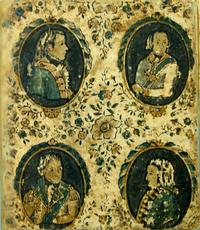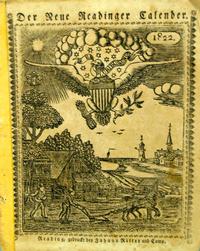The Skies Proclaim the Work of His Hands ~ Carl Friederich Egelmann (1782-1860)
By Del-Louise M.If you have a moment, I’d like to introduce you to Carl Friederich Egelmann, or Charles Frederick Egelmann as he came to be known in America. He was born in Neuenkirchen, Germany on May 12, 1782 and was only 20 when he arrived in Baltimore in 1802. There he learned the trade of coachmaker and is also known to have made chairs. However, we don’t know what aspect of coachmaking he performed, and if you think about it for a moment, you’ll realize that not just one man can make a coach. In order to create a high-class carriage several different trades are actually involved, and skilled men are required who work with materials such as wood, iron, steel, brass, cloth, leather, ivory, hair, etc. These include body makers, carriage makers, wheelwrights, joiners, fitters, several classes of smiths, painters, and polishers. Was Egelmann perhaps a painter, or some sort of smith?
After several years in Baltimore, Carl Friederich came to Pennsylvania, and was a school master in Chester, Pennsylvania. Another move brought him to Heidelberg Township or Wernersville in Berks County, and here he taught German at Hain’s Church, as well as filled the posts of choirmaster and organist. By 1815 he held similar positions in Alsace Township (Berks County). Seeking a more urban atmsophere, Egelmann came to Reading (Berks County) in the 1820s and about 1830 began to work for the German newspaper Der Readinger Democrat.
A man of decidedly many talents, he excelled in scientific enquiry, especially astronomy. For 43 years Carl Friederich furnished astronomical calculations for the principal almanacs published in America. Egelmann was also a poet, and sometimes his poems focusing on heavenly bodies are found in the almanacs. As a copper-plate engraver, he produced birth and baptismal certificates, views of local landscapes, and an instructional book Deutsche & Englische Vorschriften für die Jugend to teach children how to write in Fraktur, German script, and Roman script. It was produced in Reading in 1821. He was almost 79 when he died at Reading on Nov. 30, 1860.
The Henry Borneman Pennsylvania German Collection at the Free Library of Philadelphia has among its manuscripts Egelmann’s Commonplace Book of Formulas Along with Notes on Sundry Mechanical and Scientific Topics (Borneman Ms 98). He writes in German, and in the German script, recording mainly formulas expressing, for example, how to
· make silver letters without silver on iron or metal.
· quickly make copper and brass workable, pliant and malleable.
· make glass supple like leather.
· make steel from iron.
· prepare iron, steel, copper or other metals for engraving and cutting.
· make precious stones so soft that one can cut them like cheese.
· quickly and wisely remove rust from iron and polished steel.
· stain wood in multiple colors or solid colors.
· make a mirror.
He may have found these useful as painter or smith in the coachmaking trade, or as a chairmaker. Certainly, some of them relate directly to his work as an engraver.
There are also entries that are more personal in scope such as how to
· make a hoeing-plow.
· catch birds.
· make gut strings.
· display four elements in a glass.
· make beautiful red coral.
Egelmann must have been very interested in the hoeing-plow for he took the time to do a precise drawing of all its parts and to give detailed instructions on how to construct it. Simple in design, it may seem today to be very primitive. Perhaps he favored this particular hoeing-plow because it could be easily adjusted to plow a shallow or deep furrow, certainly a distinct advantage to anyone who had to till a field.
Three birth and baptismal certificates from the Borneman Collection demonstrate Carl Friederich’s skill as an engraver:
· a blank form FLP 130 Birth and Baptismal Certificate (Geburts und Taufschein)
· FLP 556 Birth and Baptismal Certificate (Geburts und Taufschein) for Cyrus Anspach
· FLP 1139 Birth and Baptismal Certificate (Geburts und Taufschein) for
Elisabeth Rothenberger
However, the finest example we have at the Free Library of Philadelphia of his ability to engrave is the Deutsche & Englische Vorschriften für die Jugend (FLP 27.41 (P-57)), of which all 12 leaves are copperplate engravings.
Finally, the Pennsylvania German Collection has some excellent examples of the astronomical calculations he made to one or more issues of 76 American almanacs during his lifetime, as well as some of his published poetry:
Astronomical Calculations
Egelmann’s name is listed as calculator of all the astronomical data on the title page of the North American Calender for the Year 1845:
New Calender for North America for the Year of Our Lord, 1845, a Normal Year of 365 Days, and Which after July 4th the 68th [sic] Year of American Independence. Contains the Rising, Setting and Eclipses of the Sun and Moon; the Phases, Signs and Southing of the Moon; the Aspects of the Planets, with the Rising, and Southing of the Most Conspicuous Planets and Fixed Stars; the Equation of Time, and other Miscellanies, etc. Calculated for the Latitude and Meridian of Pennsylvania and Bordering States by Carl F. Egelmann, Philadelphia, published by Mentz and Rovoudt, No. 53, North Third Street.
Published Poetry
His poem “An Astronomer’s Impressions” is found in The New Reading Calender of 1822.
In the beginning with what almighty all-encompassing force
were the heavenly bodies of eternal space, plantets and suns,
brought forth into their orbits from the bleak night!
Who maintains the order of the luminous stars?
Who rules the Suns so amazingly far away?
Who keeps the rotations of the laughing moon in check?
If your presence almighty Creator doesn’t dwell there?
Who restrains the raging seas?
Who provides sustenance, who provides bread for all?
Who is there to preserve us from all manner of deprivation?
Who gives men the capacity to think?
From whom comes reason, and who can guide it?
And who holds the scales of all in balance?
You do, o Creator! Thy kingdom come.
Carl F. Egelmann
Please be sure to visit our Facebook gallery for more images pertaining to Egelmann's Commonplace Book of Formulas Along with Notes on Sundry Mechanical and Scientific Topics (Borneman Ms 98).
Blog post and Facebook transcriptions/translations by Del-Louise Moyer
Preservation of the Free Library of Philadelphia's Pennsylvania German manuscript collection has been made possible in part by a major grant from the National Endowment for the Humanities: Because democracy demands wisdom. Any views, findings, conclusions, or recommendations expressed in this post do not necessarily represent those of the National Endowment for the Humanities.
Have a question for Free Library staff? Please submit it to our Ask a Librarian page and receive a response within two business days.



